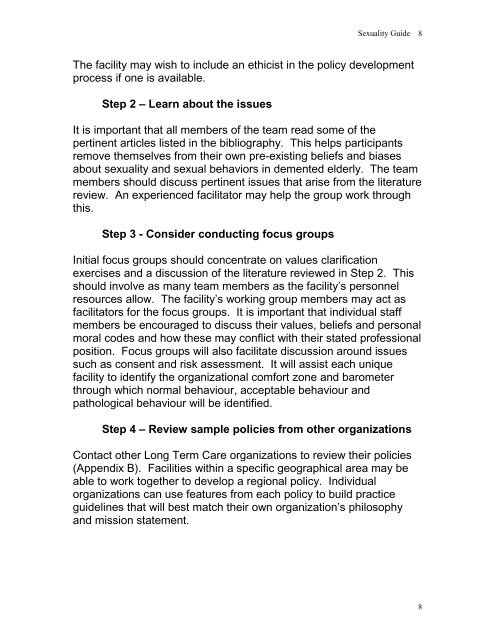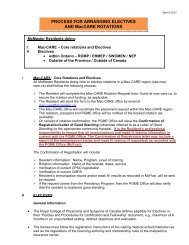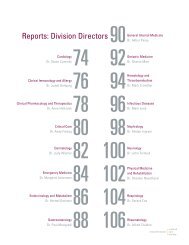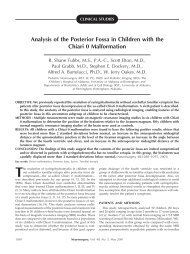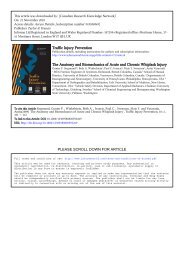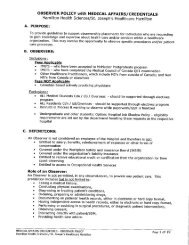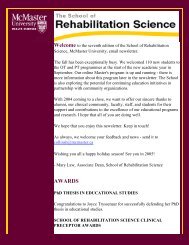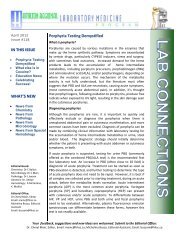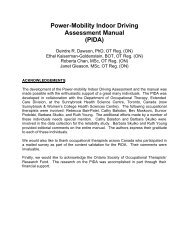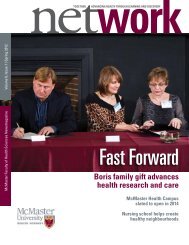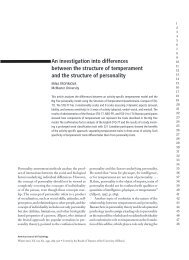Intimacy, Sexuality and Sexual Behavior in Dementia
Intimacy, Sexuality and Sexual Behavior in Dementia
Intimacy, Sexuality and Sexual Behavior in Dementia
You also want an ePaper? Increase the reach of your titles
YUMPU automatically turns print PDFs into web optimized ePapers that Google loves.
<strong><strong>Sexual</strong>ity</strong> Guide 8<br />
The facility may wish to <strong>in</strong>clude an ethicist <strong>in</strong> the policy development<br />
process if one is available.<br />
Step 2 – Learn about the issues<br />
It is important that all members of the team read some of the<br />
pert<strong>in</strong>ent articles listed <strong>in</strong> the bibliography. This helps participants<br />
remove themselves from their own pre-exist<strong>in</strong>g beliefs <strong>and</strong> biases<br />
about sexuality <strong>and</strong> sexual behaviors <strong>in</strong> demented elderly. The team<br />
members should discuss pert<strong>in</strong>ent issues that arise from the literature<br />
review. An experienced facilitator may help the group work through<br />
this.<br />
Step 3 - Consider conduct<strong>in</strong>g focus groups<br />
Initial focus groups should concentrate on values clarification<br />
exercises <strong>and</strong> a discussion of the literature reviewed <strong>in</strong> Step 2. This<br />
should <strong>in</strong>volve as many team members as the facility’s personnel<br />
resources allow. The facility’s work<strong>in</strong>g group members may act as<br />
facilitators for the focus groups. It is important that <strong>in</strong>dividual staff<br />
members be encouraged to discuss their values, beliefs <strong>and</strong> personal<br />
moral codes <strong>and</strong> how these may conflict with their stated professional<br />
position. Focus groups will also facilitate discussion around issues<br />
such as consent <strong>and</strong> risk assessment. It will assist each unique<br />
facility to identify the organizational comfort zone <strong>and</strong> barometer<br />
through which normal behaviour, acceptable behaviour <strong>and</strong><br />
pathological behaviour will be identified.<br />
Step 4 – Review sample policies from other organizations<br />
Contact other Long Term Care organizations to review their policies<br />
(Appendix B). Facilities with<strong>in</strong> a specific geographical area may be<br />
able to work together to develop a regional policy. Individual<br />
organizations can use features from each policy to build practice<br />
guidel<strong>in</strong>es that will best match their own organization’s philosophy<br />
<strong>and</strong> mission statement.<br />
8


